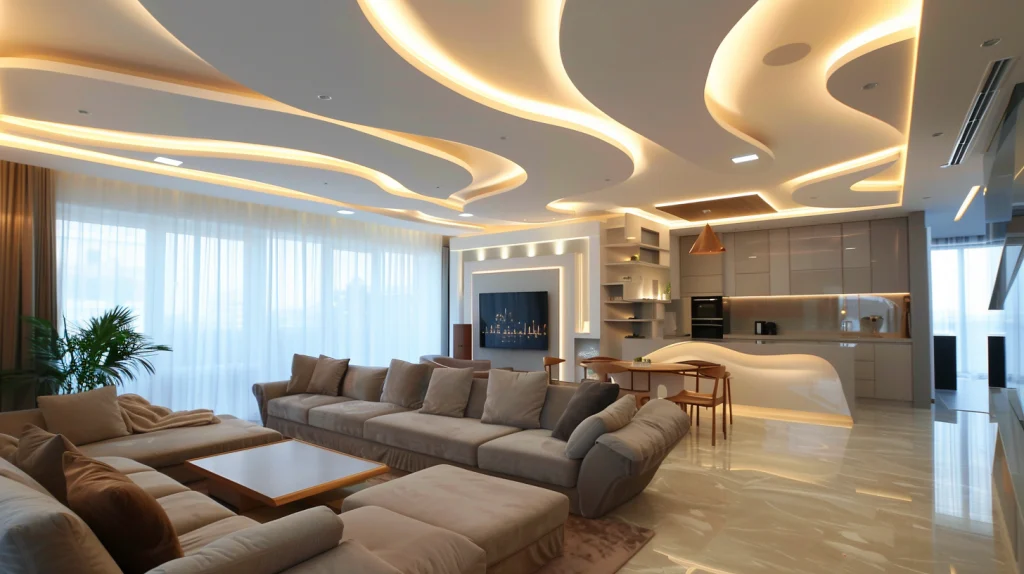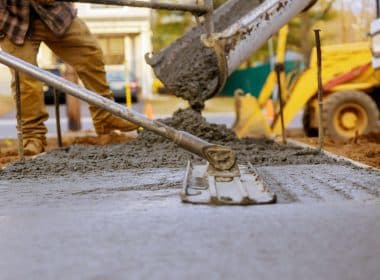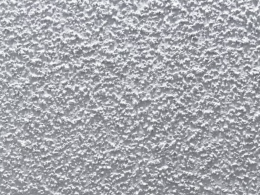When it comes to enhancing the aesthetics and functionality of your home, false ceilings play a crucial role.
They conceal unsightly wiring and ductwork and provide insulation against heat, cold, and noise.
False, suspended, or dropped ceilings have become integral to modern interior design.
Gypsum and Plaster of Paris (POP) are two popular materials for false ceilings.
In this article, we’ll explore the differences between these two options and help you decide on your home.
Whether you’re considering an open ceiling design or a more traditional look, understanding the pros and cons of gypsum and POP will guide you in choosing the best material for your needs.
So, without any further ado, let’s get started!
Significance Gypsum and POP False Ceilings
Gypsum false ceilings are made from prefabricated gypsum plasterboards that are screwed onto a metal frame attached to the main ceiling.
Gypsum is a naturally occurring mineral composed of hydrated calcium sulfate.
These boards come in various sizes and thicknesses, with common dimensions being 4×6 feet, 4×8 feet, and 4×10 feet, and thicknesses ranging from 9mm to 15mm.
Gypsum boards are known for their fire-resistant, sound-absorbing, and moisture-resistant properties.
On the other hand, POP false ceilings are created using a mixture of powdered gypsum and water, which is applied to a chicken wire mesh attached to the main ceiling.
The POP paste is then molded and sculpted into the desired shape and design.
Once dry, which can take up to a month, the POP false ceiling is ready for painting or other finishing touches.
POP is favored for its flexibility in creating intricate designs and ability to cover irregular surfaces seamlessly.
Cost Comparison: Gypsum vs. POP False Ceilings
Regarding the cost factor, the clear-cut answer to this definitive question is POP false ceilings are generally more affordable than gypsum false ceilings.
On average, POP false ceilings are about 20-40% cheaper than their gypsum counterparts.
This cost difference can be attributed to the materials used and the installation process. POP is readily available and can be mixed on-site, reducing transportation costs.
Additionally, the labor costs for POP false ceiling installation may be lower as it does not require specialized skills compared to gypsum board installation.
However, it’s essential to consider the material’s long-term value and durability rather than just its initial cost.
While gypsum boards may have a higher upfront cost, their fire-resistant properties, moisture resistance, and easier maintenance can provide better value in the long run.
Advantages and Disadvantages of Gypsum False Ceilings

Advantages:
- Quick and clean installation process
- Seamless appearance with fewer joints
- Consistent quality and finish due to factory production
- Fire-resistant and moisture-resistant properties
- Excellent sound absorption and thermal insulation
Disadvantages:
- Higher cost compared to POP
- Limited design flexibility for curved or intricate patterns
- Difficult to repair, often requiring complete board replacement
- Potential for cracks along joints due to structural movements or impact
- Susceptible to moisture damage if exposed to leaks or high humidity
Advantages and Disadvantages of POP False Ceilings

Advantages:
- Lower cost compared to gypsum boards
- High design flexibility for creating curves, cornices, and intricate patterns
- Seamless finish without visible joints
- Easy to repair and patch small damages
- Resistant to water and moisture
Disadvantages:
- Time-consuming installation process
- Requires skilled artisans for optimal results
- Potential for wastage due to on-site mixing and application
- Messy and dusty installation process
- Longer drying time, typically over a month
Factors to Consider When Choosing Between Gypsum and POP
There are multiple factors to consider that help you make a justified choice between the two false ceiling options.
For a detailed idea, we have presented a table in the segment below to help you choose your next home revamp project.
| Aspects | Plaster of Paris (POP) | Gypsum |
| Composition | Powdered form of low-moisture gypsum or calcium sulfate mixed with water on-site. | Prefabricated gypsum plasterboards made in a factory. |
| Cost-effectiveness | Approximately 25% cheaper than gypsum | More expensive than POP |
| Labor Requirements | Skilled artisans are needed to ensure proper mixing and application. | Semi-skilled laborers can handle the installation. |
| Wastage | Minimal waste as only the required quantity of powder is mixed. | Potential for significant waste due to pre-cut board sizes. |
| Durability | Prone to cracking, depending on the quality of the mix and craftsmanship. | Less likely to crack as boards are factory-produced. |
| Maintenance & Repairs | Easy to repair; only the affected area needs to be cut and remodeled. | Challenging to repair as entire boards may need to be replaced. |
| Versatility | Highly moldable and sculptable, allowing for intricate designs and seamless corners. | Flat boards with limited moldability can be combined with POP for cornices. |
| Acoustic Properties | It offers moderate sound absorption. | It provides better sound insulation compared to POP. |
| Thermal Insulation | Provides decent thermal insulation. | Superior thermal insulation properties. |
Conclusion
False ceilings have become an essential element of modern homes, offering both functional and aesthetic benefits.
Whether you opt for gypsum boards or POP, a well-designed false ceiling can transform your living space, enhance insulation, and conceal unsightly wiring and ductwork.
By understanding the pros and cons of each material and considering factors like budget, design requirements, and installation time, you can make an informed decision that best suits your needs.
Remember, the key to achieving the perfect false ceiling lies in careful planning, expert craftsmanship, and attention to detail.
With the right material and design, your false ceiling can become a stunning focal point in your home, elevating its overall ambiance and value.
So, take your time, explore your options, and create a false ceiling that reflects your style and complements your open ceiling ideas.











